The 2019 CALS Spring Symposium: Corruption

Politics; the media; the environment; economics; and, of course, the university: each of these institutions has long faced claims—from accusers both internal and external to each—of irrevocable corruption. While some of these charges point to abstract problems found in any large-scale system, others are more concrete, calling people who operate within those institutions to examine those problems as well as our own roles in allowing them to develop. Held on March 25, 2019, this year’s CALS Spring Symposium narrated multiple paths through which corruption has developed over time, and then examined what it looks like on local, national, and global levels when that corruption is deployed. Six nationally recognized scholars joined six Penn State faculty to think together about how each of us, regardless of our roles in a given system or institution, engage and are engaged in corruption. Over the course of the day, our speakers provided us with numerous means by which we might not just identify, but also work within and against the forms of corruption that appear in our daily lives.
The morning’s first panel, “The Routes and Roots of Corruption,” prompted the audience to consider how “corruption” has historically registered in cultural, literary, and social spheres. Leigh Claire La Berge (Borough of Manhattan Community College [CUNY]) opened the day with a provocation on “Corruption and Formalism.” La Berge’s talk drew connections between the role the Federal Reserve played in obfuscating the reasons behind the 2007-08 financial crash and the way artistic and literary critique creates, rather than describes, its objects of analysis. Using the concept of the loophole as a metaphor, La Berge argued that critics and economists alike rely upon analysis that locates corruption (or loopholes) in order to see how far we can push the boundaries of our fields. She closed with an idea that resounded through the rest of the day: “If we are all corrupt, then none of us is.”
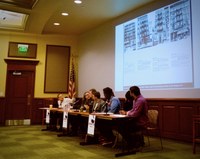
- Leigh Clare La Berge discusses the relationship between art criticism and economics, as Jeff Nealon, Michael Bérubé, Gordon Fraser, Nick Mitchell, Cynthia Young, and Akash Belsare look on
Next, Gordon Fraser (Penn State University/University of Manchester) presented a history of the political and revolutionary exploits of Robert Wilcox, who served as the first United States Congressional Representative for Hawai’i. Though his term ended with his 1903 death, Fraser’s description of the way Wilcox frequently wrote and rewrote the narrative of his own populism, bigamy, and various political machinations felt remarkably close to events unfolding in contemporary US politics, and spurred questions about the temporality and legibility of political legitimacy. Cynthia Young (Penn State University) drew from a broad lineage of African American thought to introduce the idea that “corruption” is a means for understanding how racialization—and in particular Blackness—has historically operated in US institutions ranging from higher education to the federal government. Picking up La Berge’s earlier ideas, Young concluded that “the system is not broken; it’s working as it always has.”
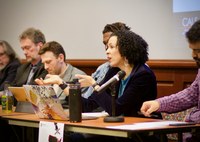
- Cynthia Young draws parallels between contemporary examples of corruption and those that emerged during the era of legal enslavement in the US
Moving back to the economic sphere, Jeffrey T. Nealon (Penn State University) concurred with Young’s point, explaining that one of the appeals of capitalism is what he called the “talismanic” quality of its promise: the meritocratic ideals of Fordist capitalism, he contended, serve as the illusion underlining the possibility that there might be some relationship between accumulation and freedom. Like Nealon, Nick Mitchell (UC Santa Cruz) traced the relationship between corruption and biopolitics – this time in university systems, in which the professoriate is the center of the institution, and many students pay to work at low-to-no wage temporary jobs. If this idealized version of the university, he asked, both serves and critiques the state, then how can it possibly escape corruption? Michael Bérubé (Penn State University) brought up one example of a problem that that inescapable relationship could cause, examining the sexual harassment case brought against NYU comparative literature professor Avital Ronell by a former graduate advisee. In Bérubé’s estimation, there were two simultaneous forms of corruption at work in the fallout that resulted from the suit: first, the threat that continuing graduate students and NYU itself faced as a direct result of Ronell’s actions, and second, the threat to the professional credibility of the many notable signatories of an open letter—written and circulated before any information about the lawsuit became public—heaping Ronell with personal and professional praise.

- Nick Mitchell (center) discusses the problems inherent in a university system that both celebrates and critiques itself
The afternoon’s roundtable, “The Art(s) of Corruption,” picked up where the morning left off, considering institutions as varied as literature, the environment, and the university as contemporary sites of corruption. Kyla Wazana Tompkins (Pomona College) opened the afternoon by listing numerous means by which nonhuman materialities are attached to human bodies, focusing on the way that idioms like “one bad apple doesn’t spoil the bunch” fail to account for systemic, and not individual, corruption, especially in systems of policing. Tompkins argued that critics rely on metaphors like this to categorize (and at times racialize) subjects, and identified English departments in particular as academic sites that encourage this practice. Next, Nicole Seymour (Cal State Fullerton) brought aesthetic analysis to the environmental movement, offering an examination of what she called “Environmental Excess.” Where excess is typically viewed as a negative component of human-environment relations, Seymour located affective excess in practices of queer camp—as, for example, Annie Sprinkle and Beth Stephens’ “Ecosex Manifesto” or the 2017 Queer Dance Party for Climate Justice—as the key to queer and trans people of colors’s survivance in material and governmental environments that typically treat them as inhuman and undeserving of care.
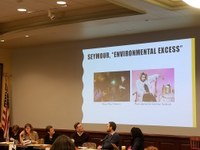
- Nicole Seymour (second from left) celebrates the role of queer excess in contemporary environmental cultures, as Rosemary Jolly, Julia Kasdorf, Scott Selisker, Eric Bennett, and Kyla Wazana Tompkins check out her slides
Eric Bennett (Providence College) offered a reading of Mark McGurl’s critical study The Program Era: Postwar Fiction and the Rise of Creative Writing (2011), treating it not as a historical account of the development of MFA programs, but instead as an artifact that traces the literary afterlives of literary figures. Bennett paid particular attention to The Program Era’s misrepresentation of the life of Flannery O’Connor, arguing that McGurl’s unscrupulous research practices reflect his own self-policing and self-narration and not O’Connor’s lived reality. Julia Kasdorf (Penn State University) brought props for her presentation on fracking and remote drilling in Appalachia, illuminating the metaphoric relationship between literary interpretation and extraction culture in a geographic region that houses Pennsylvania’s largest university: our own. “CORRUPTION IS THE NORM,” read one of her protest signs. Picking up these themes, Scott Selisker (University of Arizona) wondered which public the university–-or any large institution–-believes itself to serve. Though it sounds paradoxical, backchannels and an avowedly anti-institutional ethos are all part of belonging to an institution, he contended, locating corruption at the intersection of the private agent and the public official, both of whom often work past (and not with) the communities they profess to serve. Finally, Rosemary Jolly (Penn State University) introduced to the conversation the importance of witness texts, or those accounts that relate secondhand experience in the absence of a primary source. In institutions like governments and NGOs where corruption registers on the level of human rights violations, there are no original texts, but only received narratives.
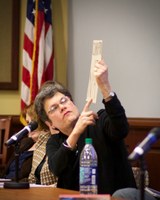
- Julia Kasdorf holds up an anti-fracking sign that reads CORRUPTION IS THE NORM as she discusses the relationship between extraction culture and literary critique in Central Pennsylvania
A panel of graduate student symposium organizers who summed up the day’s events touched on equally varied topics, offering comments that considered hope, embodiment, narrative, and personal politics as ways to resist the forms of corruption embedded in the institutions in which each symposium participant is enmeshed. Audience questions concluded the day, spurring conversation about the relationship between power and corruption, the nature of critique, the way that corruption moves and changes over time, and the possibilities of changing our own corrupted practices. Corruption is a feature of institutions, rather than a bug; while it may prove difficult or even impossible to avoid it where it already exists, we must begin working with each other, rather than with the already-corrupt systems of which we are a part, as a way of resisting all its potentially totalizing power.
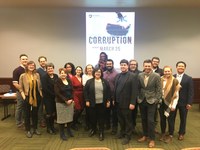
- L-R: Scott Selisker, Nicole Seymour, Eric Bennett, Julia Kasdorf, Rosemary Jolly, Kyla Wazana Tompkins, Emily Smith, Leigh Clare La Berge, Miriam Gonzales, Nick Mitchell, Akash Belsare, Sean Goudie, Jeffrey T. Nealon, Gordon Fraser, Patrick Allen, Emily Morrison, Rob Nguyen

Politics; the media; the environment; economics; and, of course, the university: each of these institutions has long faced claims—from accusers both internal and external to each—of irrevocable corruption. While some of these charges point to abstract problems found in any large-scale system, others are more concrete, calling people who operate within those institutions to examine those problems as well as our own roles in allowing them to develop. Held on March 25, 2019, this year’s CALS Spring Symposium narrated multiple paths through which corruption has developed over time, and then examined what it looks like on local, national, and global levels when that corruption is deployed. Six nationally recognized scholars joined six Penn State faculty to think together about how each of us, regardless of our roles in a given system or institution, engage and are engaged in corruption. Over the course of the day, our speakers provided us with numerous means by which we might not just identify, but also work within and against the forms of corruption that appear in our daily lives.
The morning’s first panel, “The Routes and Roots of Corruption,” prompted the audience to consider how “corruption” has historically registered in cultural, literary, and social spheres. Leigh Claire La Berge (Borough of Manhattan Community College [CUNY]) opened the day with a provocation on “Corruption and Formalism.” La Berge’s talk drew connections between the role the Federal Reserve played in obfuscating the reasons behind the 2007-08 financial crash and the way artistic and literary critique creates, rather than describes, its objects of analysis. Using the concept of the loophole as a metaphor, La Berge argued that critics and economists alike rely upon analysis that locates corruption (or loopholes) in order to see how far we can push the boundaries of our fields. She closed with an idea that resounded through the rest of the day: “If we are all corrupt, then none of us is.”

- Leigh Clare La Berge discusses the relationship between art criticism and economics, as Jeff Nealon, Michael Bérubé, Gordon Fraser, Nick Mitchell, Cynthia Young, and Akash Belsare look on
Next, Gordon Fraser (Penn State University/University of Manchester) presented a history of the political and revolutionary exploits of Robert Wilcox, who served as the first United States Congressional Representative for Hawai’i. Though his term ended with his 1903 death, Fraser’s description of the way Wilcox frequently wrote and rewrote the narrative of his own populism, bigamy, and various political machinations felt remarkably close to events unfolding in contemporary US politics, and spurred questions about the temporality and legibility of political legitimacy. Cynthia Young (Penn State University) drew from a broad lineage of African American thought to introduce the idea that “corruption” is a means for understanding how racialization—and in particular Blackness—has historically operated in US institutions ranging from higher education to the federal government. Picking up La Berge’s earlier ideas, Young concluded that “the system is not broken; it’s working as it always has.”

- Cynthia Young draws parallels between contemporary examples of corruption and those that emerged during the era of legal enslavement in the US
Moving back to the economic sphere, Jeffrey T. Nealon (Penn State University) concurred with Young’s point, explaining that one of the appeals of capitalism is what he called the “talismanic” quality of its promise: the meritocratic ideals of Fordist capitalism, he contended, serve as the illusion underlining the possibility that there might be some relationship between accumulation and freedom. Like Nealon, Nick Mitchell (UC Santa Cruz) traced the relationship between corruption and biopolitics – this time in university systems, in which the professoriate is the center of the institution, and many students pay to work at low-to-no wage temporary jobs. If this idealized version of the university, he asked, both serves and critiques the state, then how can it possibly escape corruption? Michael Bérubé (Penn State University) brought up one example of a problem that that inescapable relationship could cause, examining the sexual harassment case brought against NYU comparative literature professor Avital Ronell by a former graduate advisee. In Bérubé’s estimation, there were two simultaneous forms of corruption at work in the fallout that resulted from the suit: first, the threat that continuing graduate students and NYU itself faced as a direct result of Ronell’s actions, and second, the threat to the professional credibility of the many notable signatories of an open letter—written and circulated before any information about the lawsuit became public—heaping Ronell with personal and professional praise.

- Nick Mitchell (center) discusses the problems inherent in a university system that both celebrates and critiques itself
The afternoon’s roundtable, “The Art(s) of Corruption,” picked up where the morning left off, considering institutions as varied as literature, the environment, and the university as contemporary sites of corruption. Kyla Wazana Tompkins (Pomona College) opened the afternoon by listing numerous means by which nonhuman materialities are attached to human bodies, focusing on the way that idioms like “one bad apple doesn’t spoil the bunch” fail to account for systemic, and not individual, corruption, especially in systems of policing. Tompkins argued that critics rely on metaphors like this to categorize (and at times racialize) subjects, and identified English departments in particular as academic sites that encourage this practice. Next, Nicole Seymour (Cal State Fullerton) brought aesthetic analysis to the environmental movement, offering an examination of what she called “Environmental Excess.” Where excess is typically viewed as a negative component of human-environment relations, Seymour located affective excess in practices of queer camp—as, for example, Annie Sprinkle and Beth Stephens’ “Ecosex Manifesto” or the 2017 Queer Dance Party for Climate Justice—as the key to queer and trans people of colors’s survivance in material and governmental environments that typically treat them as inhuman and undeserving of care.

- Nicole Seymour (second from left) celebrates the role of queer excess in contemporary environmental cultures, as Rosemary Jolly, Julia Kasdorf, Scott Selisker, Eric Bennett, and Kyla Wazana Tompkins check out her slides
Eric Bennett (Providence College) offered a reading of Mark McGurl’s critical study The Program Era: Postwar Fiction and the Rise of Creative Writing (2011), treating it not as a historical account of the development of MFA programs, but instead as an artifact that traces the literary afterlives of literary figures. Bennett paid particular attention to The Program Era’s misrepresentation of the life of Flannery O’Connor, arguing that McGurl’s unscrupulous research practices reflect his own self-policing and self-narration and not O’Connor’s lived reality. Julia Kasdorf (Penn State University) brought props for her presentation on fracking and remote drilling in Appalachia, illuminating the metaphoric relationship between literary interpretation and extraction culture in a geographic region that houses Pennsylvania’s largest university: our own. “CORRUPTION IS THE NORM,” read one of her protest signs. Picking up these themes, Scott Selisker (University of Arizona) wondered which public the university–-or any large institution–-believes itself to serve. Though it sounds paradoxical, backchannels and an avowedly anti-institutional ethos are all part of belonging to an institution, he contended, locating corruption at the intersection of the private agent and the public official, both of whom often work past (and not with) the communities they profess to serve. Finally, Rosemary Jolly (Penn State University) introduced to the conversation the importance of witness texts, or those accounts that relate secondhand experience in the absence of a primary source. In institutions like governments and NGOs where corruption registers on the level of human rights violations, there are no original texts, but only received narratives.

- Julia Kasdorf holds up an anti-fracking sign that reads CORRUPTION IS THE NORM as she discusses the relationship between extraction culture and literary critique in Central Pennsylvania
A panel of graduate student symposium organizers who summed up the day’s events touched on equally varied topics, offering comments that considered hope, embodiment, narrative, and personal politics as ways to resist the forms of corruption embedded in the institutions in which each symposium participant is enmeshed. Audience questions concluded the day, spurring conversation about the relationship between power and corruption, the nature of critique, the way that corruption moves and changes over time, and the possibilities of changing our own corrupted practices. Corruption is a feature of institutions, rather than a bug; while it may prove difficult or even impossible to avoid it where it already exists, we must begin working with each other, rather than with the already-corrupt systems of which we are a part, as a way of resisting all its potentially totalizing power.

- L-R: Scott Selisker, Nicole Seymour, Eric Bennett, Julia Kasdorf, Rosemary Jolly, Kyla Wazana Tompkins, Emily Smith, Leigh Clare La Berge, Miriam Gonzales, Nick Mitchell, Akash Belsare, Sean Goudie, Jeffrey T. Nealon, Gordon Fraser, Patrick Allen, Emily Morrison, Rob Nguyen